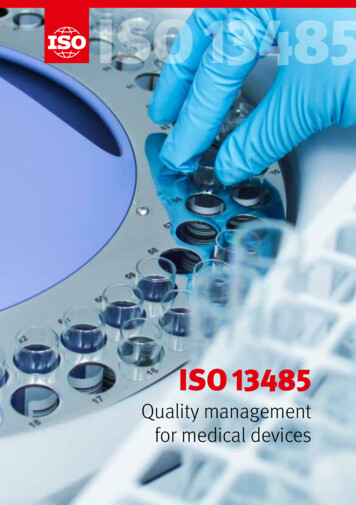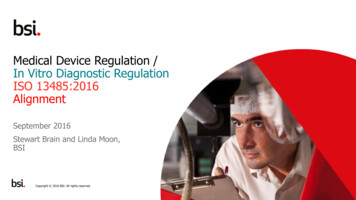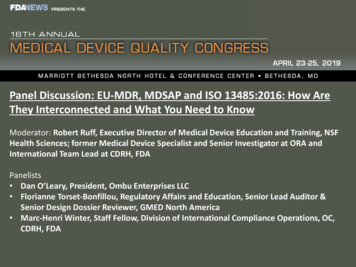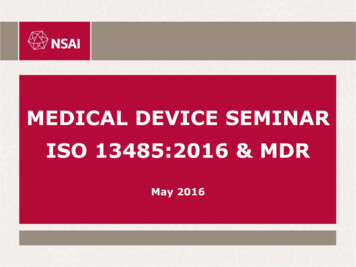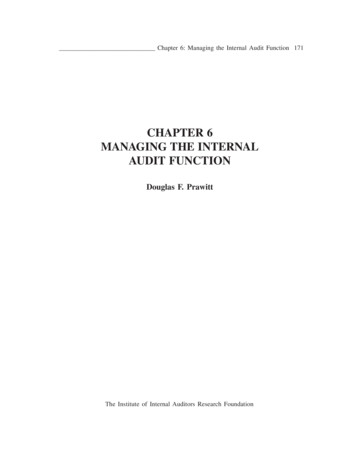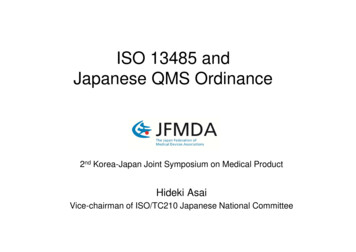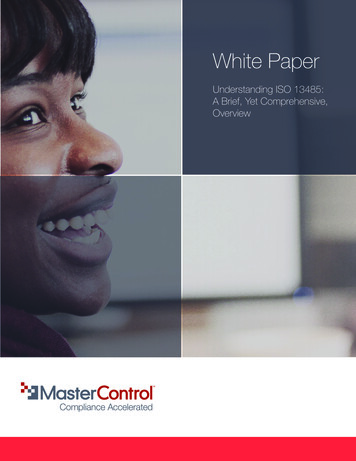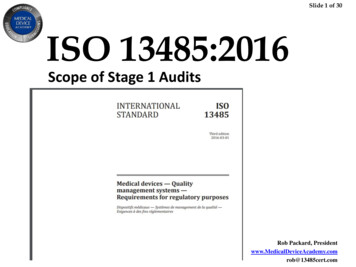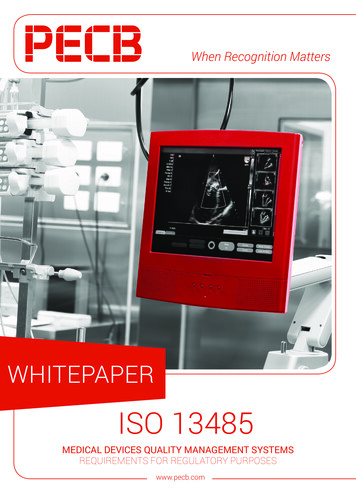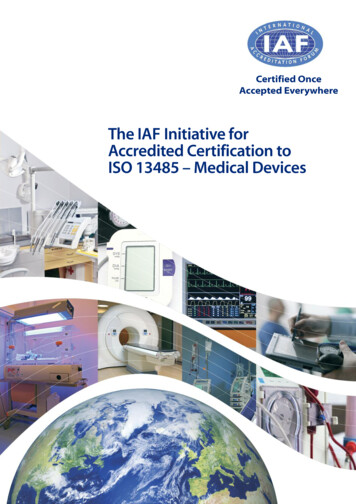
Transcription
Certified OnceAccepted EverywhereThe IAF Initiative forAccredited Certification toISO 13485 – Medical Devices
Contents2Introduction3ISO 13485 accredited certification withina national regulatory framework4Relationship to guidance from theGlobal Harmonization Task Force (GHTF)6How ISO 13485 certification relatesto product certification7The IAF Multilateral RecognitionArrangement (MLA)8Structure of the MLA8IAF MLA Mark9Key Features of the Initiative10Reports associated with the IAF Initiative12Using Accredited ISO 13485Certification in Practice13The IAF Initiative for Accredited Certification to ISO 13485 – Medical Devices
IntroductionThe purpose of this brochure is to explain the benefits and use of theISO 13485 Medical Device initiative developed by the InternationalAccreditation Forum (IAF).The initiative enables IAF accredited certificationbodies to provide consistent, credible certification toISO 13485. The documents, developed as part ofthe IAF initiative, which are mandatory to bothaccreditation bodies within IAF and all certificationbodies accredited by them to provide certification toISO 13485, also enable national authorities with anopportunity to enhance their healthcare systemsthrough the implementation of accredited ISO 13485certification, without losing valuable access tomedical devices that they are already using.This brochure describes the importance of accreditedcertification and the roles and responsibilities of thedifferent stakeholders with an interest in this scheme.It explains the context within which ISO 13485accredited certification is expected to be used andthe links between this and medical device trade andpublic health.Objectives of the InitiativelllApplication of the initiative enables IAFaccredited certification bodies to provideconsistent, credible certification to ISO 13485.The initiative documents, which are mandatoryto both accreditation bodies within IAF and allcertification bodies accredited by them to providecertification to ISO 13485.To enable national authorities with an opportunityto enhance their healthcare systems through theimplementation of accredited ISO 13485certification, without losing valuable access tomedical devices.This informative guidance is intended to help theunderstanding of the utilisation of ISO 13485accredited certification.The IAF Initiative for Accredited Certification to ISO 13485 – Medical Devices3
ISO 13485 accredited certification within a nationalregulatory frameworkGranting healthcare practitioners access to medical devices that are made inanother country is critical to all healthcare systems. Indeed, most countriesimport more medical devices than they export. Each country must sensiblyregulate access to medical devices in order to protect their citizens fromunsafe devices.Regulators are increasingly realizing the benefit ofrecognizing the quality management system standardISO 13485 – Medical Devices – Quality ManagementSystems – Requirements for Regulatory Purposes. Thisinternational standard provides the basis for medicaldevice regulations to be harmonized around the world.Just as doctors and patients benefit from receivingmedical devices made outside their country, medicaldevice industries throughout the world benefit frombeing able to provide them. In 2011, there were6.5 billion people in the world living in 192 countries.Many of these countries do not have harmonizedmedical device regulations to protect their citizens, yetthe need to protect their citizens is great. As eachnation develops its own national medical deviceregulations, the likely increased demand for nationalfactory audits would become impossible to bear for amanufacturer. This would not merely result in a barrierto trade for the supplier, but also a barrier to care forthe importing country. Many countries import morethan 90% of their healthcare technologies. By utilizingthe international standard ISO 13485, with cooperationof IAF member accreditation bodies, the medicaldevice industry can be provided with one ISO 13485certificate that can be accepted everywhere, while alsomeeting the importing countries demand for safe andeffective medical devices.4Use of this initiative very much depends uponawareness among the global regulatory community.In particular, organizations such as the GlobalHarmonization Task Force (GHTF), Pan American HealthOrganization (PAHO), Asian Harmonization WorkingParty (AHWP) and Association of Southeast AsianNations (ASEAN) are very important to theharmonization of medical device regulations. However,even with the endorsement of such organizations, it isequally important that individual regulatory authoritiesare aware of the requirements and structure of thisinitiative.ISO 13485 is intended to address medical deviceregulatory requirements for a quality managementsystem. Although ISO 13485 is based on the QualityManagement Systems standard ISO 9001, it focusesless on business performance and more on riskmanagement. ISO 13485 ensures that medical devicemanufacturers consistently produce medical devicesthat meet regulatory requirements and are designedand manufactured to be safe for their intended use.Many international regulators have directly orindirectly endorsed use of ISO 13485 as the model formeeting their own regulatory requirements formedical device manufacturing. Many countries havedeveloped their medical device regulations usingISO 13485 or the criteria within it, and other countriesare now using or beginning to use this same standardin their medical device regulations.The IAF Initiative for Accredited Certification to ISO 13485 – Medical Devices
Medical device regulators, certification bodies andmembers of GHTF have worked together to provide acommon framework for regulating medical devices.GHTF Study Group 3 has created several documentsthat provide helpful guidance on the application andinterpretation of ISO 13485. GHTF Study Group 4provides guidance on the methodologies andrequirements for the audit of quality systems againstISO 13485.provided by IAF, there remains the potential for variationsof credibility among issued ISO 13485 certificates.The IAF documents were created to be used fordeveloping and improving medical device regulationsaround the world, while preventing unnecessarybarriers to care at the national level.A summary of the relationships between keystakeholders is shown in the following diagram:The IAF initiative enables consistent and credibleISO 13485 certification. Without the harmonizationPUBLIC HEALTHHEALTHCAREPUBLIC HEALTHCAREPROTECTIONMEDICAL DEVICESClassified Low Risk DevicesExempt from ISO 13485National Regulation Recognises “ISO 13485 IAF Accredited Certificates”Medical DeviceRegistrationRegulatory Authority (RA)IAF MandatoryDocumentsMD8 for application of ISO 17011Accreditation Body (AB)MD9 for application of ISO 17021Conformity Assessment Body (CAB)ISO 13485Manufacturer of Medical DeviceThe IAF Initiative for Accredited Certification to ISO 13485 – Medical DevicesISO 13485AccreditedCertificate5
Relationship to guidance from the Global HarmonizationTask Force (GHTF)The IAF ISO 13485 medical devices initiative has been optimized using GHTFguidance. For many years, GHTF members have strived to create a system ofdocuments that can form the basis for medical device regulatory programsworldwide.The IAF initiative utilizes GHTF guidance from StudyGroup 4 concerning regulatory auditing practices.The initiative incorporates this guidance to supportan infrastructure that links regulatory authorities,accreditation bodies, certification bodies, andmedical device manufacturers.Therefore regulators should make the medical deviceindustry aware of any national deviations from the GHTFapproach that could possibly cause manufacturersdelays in compliance. It is also very important toconsider the restrictions on legal access to medicaldevices that may result from imposing deviations.The IAF initiative for ISO 13485 does not require useof any additional GHTF documents. IAF accreditedcertification does however support regulations thatincorporate other GHTF guidance. If GHTF guidance isto be used in forming a new medical device regulation,the following uses of GHTF guidance should beconsidered.Note: Whilst the long-term future of the GHTF is notcertain, as at 2011 the view of achieving harmonisedregulatory requirements remains a highly desirableobjective, particularly in view of the pressures of aglobalised manufacturing market for medical devicesand increasing demands to streamline regulatoryprocesses in order to deliver high quality products to themarketplace with minimal delays. The GHTF regulator’sgroup considered that the best way to achieve such anoutcome was to develop a regulator-led harmonisationand collaboration group that would allow for moredetailed discussion between members on the optimumways to achieve harmonisation at an operational level.The strategy of achieving this, together with adequateinput and advice from industry, was still underconsideration in mid-2011.Guidance documents from GHTF Study Groups 1, 2, 3,and 5 describe core concepts for developing aharmonized medical device regulatory system.Regulators may reference such documents for use ascriteria that manufacturers must follow or they mayadopt the language directly into national law. GHTFStudy Group 4's guidance relevant to IAF ISO 13485accredited certification has already been included inthe IAF Mandatory Document for the application ofISO/IEC 17021 (IAF MD9).Regulatory bodies may not want or be able to fullyimplement all documents and requirements of theGHTF due to particular local or national concerns.6The IAF Initiative for Accredited Certification to ISO 13485 – Medical Devices
How ISO 13485 certification relates to product certificationAlthough an audit performed under the ISO 13485 may include anexamination of a product’s design and development, ISO 13485 is not aproduct certification standard. The certification based on ISO 13485 is notdirectly linked to the specification of the manufactured products. ISO 13485certification indicates that the processes for designing and manufacturingmedical devices are appropriate for providing consistent product qualityand safety.The IAF Initiative for Accredited Certification to ISO 13485 – Medical Devices7
The IAF Multilateral Recognition Arrangement (MLA)IAF is an organization of accreditation bodies and other interested stakeholdersfrom more than 50 countries. Most accreditation bodies operate under theauthority of their own nation’s government and cooperate in the developmentand maintenance of Multilateral Recognition Arrangements (MLAs).Signatories to the IAF MLA agree to promote acceptance of accreditedcertificates issued by all the other IAF MLA signatories within the scope of theMLA. Thus the MLA underpins the recognition of ISO 13485 certificatesissued by certification bodies accredited by IAF member accreditation bodies.Structure of the MLACertificates issued by bodies accredited by the IAFMLA Signatories can be relied upon throughout theworld because the MLA assures the credibility of thecertificate to customers.application of ISO/IEC 17021 for theMedical Device Quality ManagementSystems (ISO 13485).Level 5 – ISO 13485.The MLA is structured in 5 levels. ISO 13485 fits intothese levels as follows:Accreditation bodies that are signatories to the IAFMLA may extend their scope of operation to includemedical devices if they accredit certification bodiesthat issue ISO 13485 certificates. They will do this eitherdirectly to IAF or through their regional group if theregional group includes ISO 13485 as part of theirregional MLA.Level 1 – Includes ISO/IEC 17011 and the IAFMandatory document (MD8) on theapplication of ISO/IEC 17011 in MedicalDevice Quality Management Systems(ISO 13485);Level 2 – Describes the type of conformityassessment activity e.g. ManagementSystems. The IAF accreditation system forISO 13485 will form part of managementsystem activities (no additionaldocumentation required);Level 3 – ISO/IEC 17021;Level 4 – The sector specific requirements havebeen developed by the IAF TechnicalCommittee and are contained in the IAFmandatory document (MD 9) on the8The IAF Initiative for Accredited Certification to ISO 13485 – Medical Devices
IAF MLA MarkThe documentation has been developed to ensure that the initiative gains asmuch advantage from the IAF MLA as possible by ensuring that accreditedcertificates issued to ISO 13485 are able to include the IAF MLA Mark, which isthe IAF MLA Mark in combination with the symbol of the accreditation body.The IAF MLA Mark will not appear on certificates on its own.The IAF MLA mark’s appearance on an ISO 13485Certificate assures the user of the certificate that theISO 13485 audit is highly credible and operatingunder IAF MLA Management.The Mark demonstrates that the certificate has beenissued by a certification body that is accredited by anIAF MLA member and is thus traceable to the highestauthority. It is an assurance that the certificate and theissuing body are of a high standard of competenceand may be trusted, as they are recognised ascomplying to the same set of standards at theglobal level.To ensure that the IAF MLA Mark may be used onaccredited certificates, the initiative has beenendorsed by the IAF in accordance with the documentIAF PL3.The IAF MLA mark can be used by accreditationbodies to demonstrate their status as a signatoryto the IAF MLA. Accredited certification bodies canalso use the mark in combination with theaccreditation symbol on their certificates providingthey are issued in association with IAF endorsednormative documents such as ISO 13485.The IAF Initiative for Accredited Certification to ISO 13485 – Medical Devices9
Key Features of the InitiativeThe relationship of Risk Classification of Medical Devices to QMS requirementsThe significance of risk classification to the QMS is thatbased on whether the medical device is higher orlower risk, the regulator may or may not require themanufacturer’s quality management system to beindependently certified to ISO 13485. The purpose ofclassification is to match regulatory oversight andmarket clearance to the level of risk of the device’s risk.Lower risk medical devices usually do not requireindependent certification of the manufacturer’s QMS.The illustration below is a very basic example of howISO 13485 certification could be applied to fourdifferent risk classifications for medical devices:Manufacturer’s Obligations to a Quality Management SystemMedical DeviceRisk ClassificationGHTFRiskClassHigh RiskMedium-high RiskMedium-low RiskLow RiskDCBAIAF accreditedcertification toISO 13485IAF accreditedcertification toISO 13485IAF accreditedcertification toISO 13485Not RequiredRequiredIncluding Designand DevelopmentControlsxxxx**Low risk medical devices are exempt from ISO 13485 Certification10The IAF Initiative for Accredited Certification to ISO 13485 – Medical Devices
Two approaches to that are widely used to determine risk classification:Risk classification rulesRisk classification namesRisk “classification rules” use general principles of risk,related to patient contact with energy, substances,invasiveness into the body, as well as other criteria, todetermine the risk level of a medical device. Higherrisk devices have a contact with the body for a longertime period than lower risk devices. They are moreinvasive inside the body or rely on a more hazardousenergy sources. Several risk rules can be found toapply to one medical device. It is the responsibility ofthe manufacturer to apply the higher risk classificationwhen more than one risk classification is identifiedusing applicable risk rules. A full list of risk classificationrules can be viewed in the GHTF document SG1-N15:2006 – “Principles of Medical Devices Classification”.Risk classification names appear as an assigned riskclassification next to the name of the medical devicetype (e.g. Blood Pressure Cuff – Class B). The MedicalDevices risk classifications are then made public andallow the regulatory authority to adjust the riskclassification more easily, if post market experienceshows a particular product to be more, or less safethan originally thought. Changing a risk classificationfor one product, does not change the riskclassification of another. Risk classifications may beassigned by consensus from a group of medicaldevice experts. Some medical device experts use riskclassification rules to assign the first risk classificationfor a new type of medical device.Although the IAF initaitive for ISO 13485 does notprescribe any risk classification system, requirementsfor ISO 13485 certification should be based on the riskof a device to public health.The IAF Initiative for Accredited Certification to ISO 13485 – Medical Devices11
Reports associated with the IAF InitiativeReports exist on how the participants at the different layers within the IAF ISO 13485 certification initiativemeet the particular requirements that are appropriate for them:Accreditation body peer evaluation reportMedical device manufacturer’s audit reportUnder the IAF MLA, a peer evaluation report coversthe accreditation body’s performance in meeting,among other things, the IAF Mandatory Document forthe application of ISO/IEC 17011 – ConformityAssessment – General Requirements for AccreditationBodies Accrediting Certification Bodies in the MedicalDevice Quality Management Systems (ISO 13485).This is the audit report prepared by the certificationbody that indicates the medical device manufacturer’sperformance in meeting, among other things, therequirements of the quality management systemstandard ISO 13485.Assessment report on the certification bodyUnder the accreditation for ISO 13485 by IAFaccreditation body members, the accreditation bodyprovides an accreditation assessment report of acertification body’s performance in meeting, amongother things, the IAF Mandatory Document for theapplication of ISO/IEC 17021– Conformity Assessment –Requirements for Bodies Providing Audit and Certificationof Management Systems in the Medical Device QualityManagement Systems (ISO 13485).12Regulatory authorities that have specified the use ofthe IAF accredited ISO 13485 certification initiative intheir legislation may be provided access to theaccreditation body, certification body and theparticipating medical device manufacturer’s reportsand facilities.The IAF Initiative for Accredited Certification to ISO 13485 – Medical Devices
Using Accredited ISO 13485 Certification in PracticePractical Aspects of Specifying IAF Accredited ISO 13485 Certificates in Medical DeviceRegulationsRequirements for IAF accredited certification aredesigned to enforce one credible and transparentISO 13485 audit to meet the needs of regulatoryauthorities. In order for this to occur, ISO 13485certificates should be identified in the national medicaldevice regulation through appropriate nationallegislative processes.By recognizing IAF accredited ISO 13485 certificates inthe national legislation, countries gain access to theaudit reports in addition to being able to inspect anyparticipating accreditation body, certification body ormedical device manufacturer. Although there aremany ways in which ISO 13485 accredited certificatesmay be included into a new medical deviceregulation, the most likely approach would be tospecify it as a requirement for registering medium\riskor higher risk medical devices with the RegulatoryAuthority.An example of how a national medical deviceregulation could reference IAF accredited ISO 13485certificates is provided below.The use of the IAF accredited ISO 13485 certificationprogram can make a significant contribution towardsdeveloping a harmonized medical device regulation.It does not, however, describe or mention MedicalDevice Reporting (MDR), how to classify the risk levelof a medical device or how they should be labelled.IAF accredited ISO 13485 certificates are expected to bepart of the medical device regulation that pertains toproduct registration and quality management systemrequirements. The GHTF provides free, detailedguidance at www.ghtf.org for developing a morecomplete and harmonized medical device regulation.[Regulation Number]Medical Device RegistrationAn application for registering a class 2 or highermedical device shall be submitted to the[Name of Regulatory Authority]by the manufacturer and shall contain the following:a) A copy of a current and valid IAF accreditedISO 13485 quality management system certificatecertifying that the quality management systemunder which the device is manufactured satisfiesISO 13485 Medical devices – Quality managementsystems – Requirements for regulatory purposes.b) .other requirement(s)The IAF Initiative for Accredited Certification to ISO 13485 – Medical Devices13
Using Accredited ISO 13485 Certification in Practice continuedConsidering exemptions for ISO 13485 certificationIn 2011, there are an estimated 5,000 different medicaldevice categories that account for 90,000 differentproducts used by healthcare systems worldwide.More than 50% of these medical devices areconsidered low risk. Many low risk medical devicesare safer than less regulated consumer products.Allowing healthcare professionals access to a widerrange of medical devices provides a necessary benefitto a country’s healthcare system. AccreditedISO 13485 certification is suggested for regulatingmedium to high risk medical devices.Transition period for requiring IAF accredited ISO 13485 certificatesAlthough it is expected that accredited certificates forISO 13485 will become available within the first yearof its adoption by IAF, regulators need to providemanufacturers with an opportunity to learn and adaptto any new regulation. Enforcing IAF accreditedcertification before industry has had time to preparecould have an adverse impact on the healthcaresystem if it is enforced too soon. Each country thatadopts the IAF accredited certification to ISO 13485into its regulations should make the new regulationas widely known as possible to provide medicaldevice manufacturers time to prepare. It isrecommended that a transition period of three yearsbe provided to allow all stakeholders time to adjust tothe IAF accreditation requirements.Communication between StakeholdersIn order for this IAF accredited ISO 13485 CertificationInitiative to contribute to an efficient regulatorysystem, it is vital for effective communication channelsto exist between regulators, accreditation bodies andconformity assessment bodies. Communication is akey element of this initiative and is intended tosupport mutual confidence building.14It is recommended that regulators establish acommunication framework between them and theirlocal accreditation body that is visible to theconformity assessment bodies and medical devicemanufacturers.The IAF Initiative for Accredited Certification to ISO 13485 – Medical Devices
The IAF Initiative for Accredited Certification to ISO 13485 – Medical Devices15
Certified OnceAccepted EverywhereIAF SecretariatElva Nilsen28 Chemin Old ChelseaBox 1811Chelsea, QuebecCANADA J9B 1A0Phone: 1 (613) 454 8159Email: iaf@iaf.nuwww.iaf.nuIAF B5 1/2012
ISO 13485 or the criteria within it,and other countries are now using or beginning to use this same standard in their medical device regulations. 4. The IAF Initiative for Accredited Certification to ISO 13485 –Medical D
